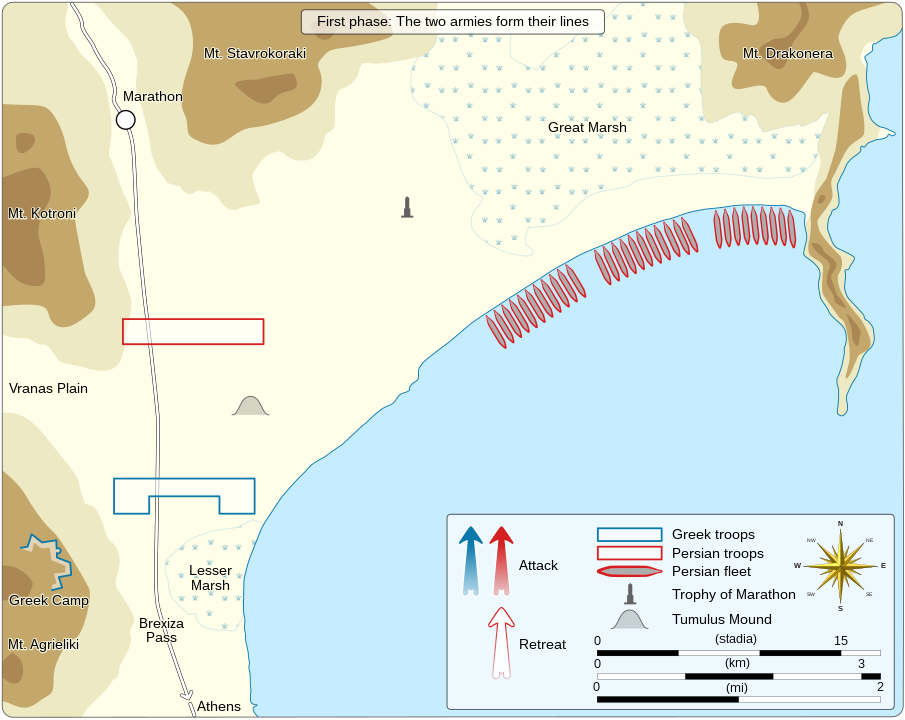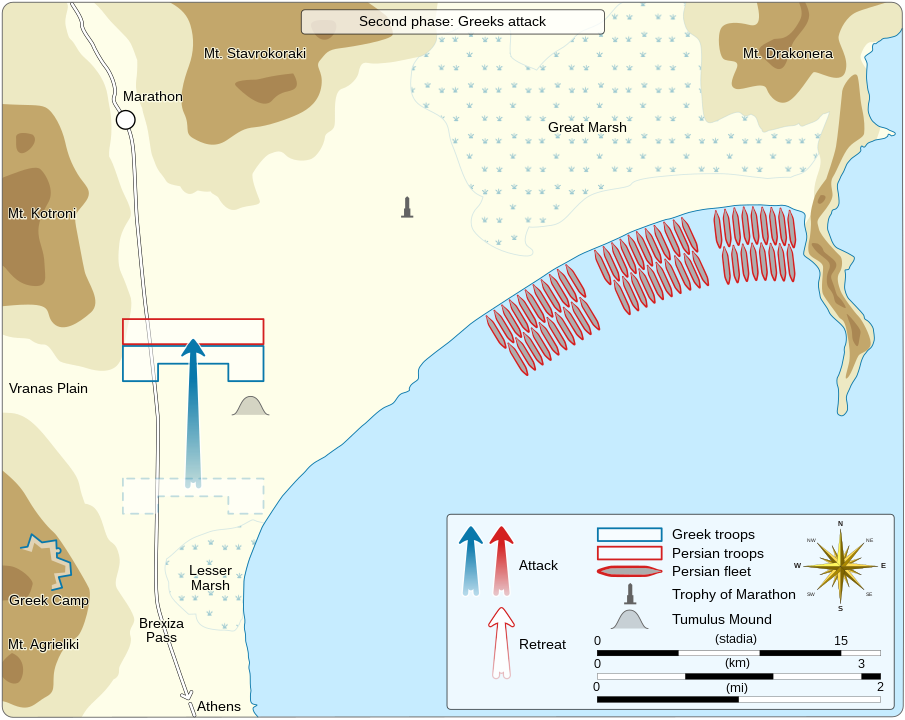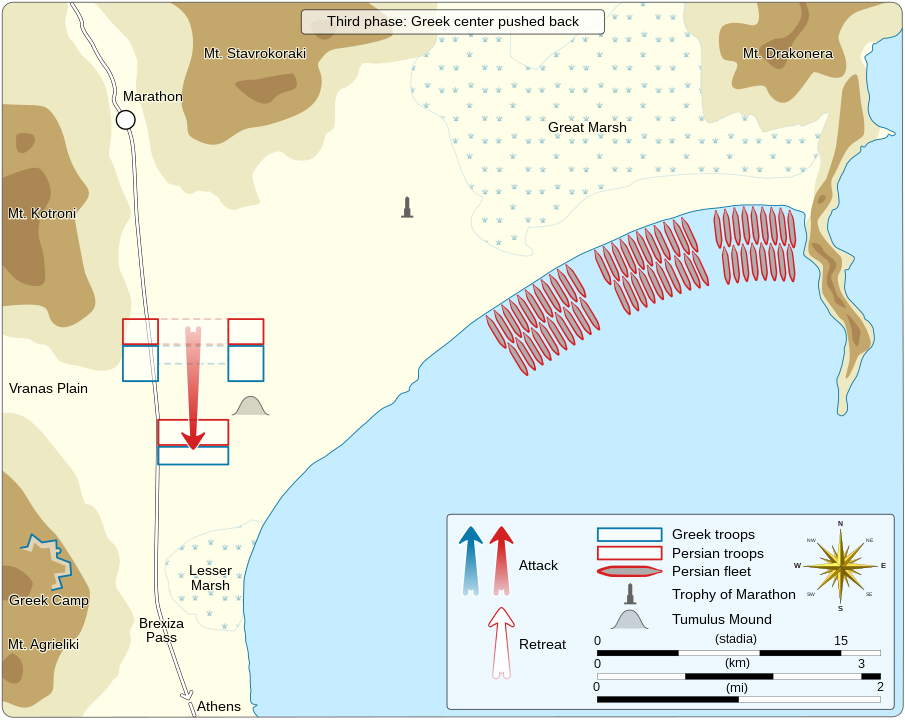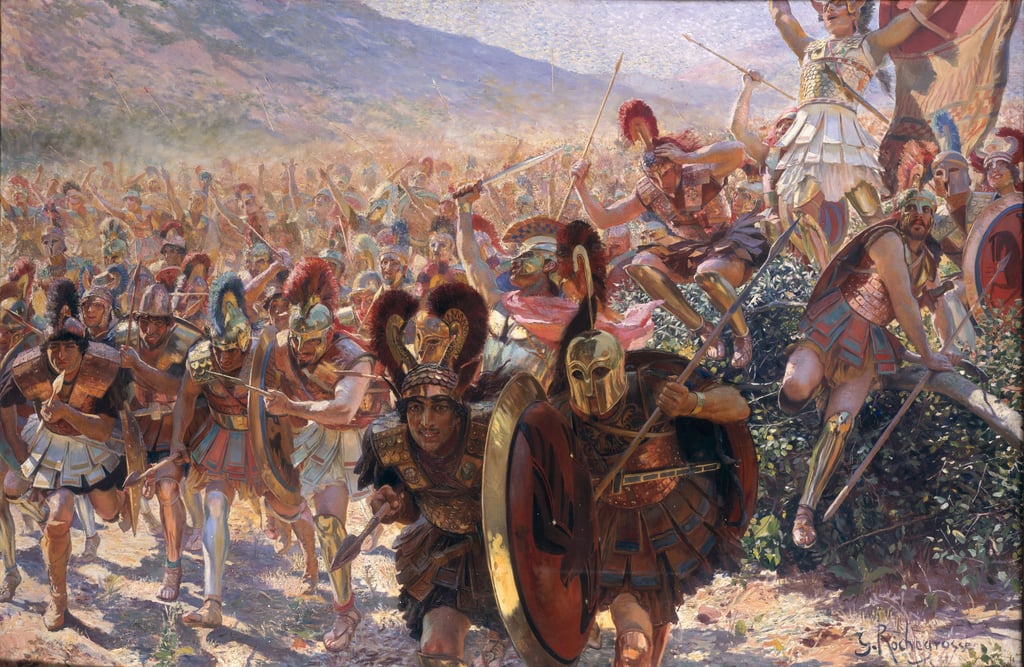Introduction
The Battle of Marathon was a pivotal moment in ancient Greek history. An epic clash fought between the Athenian army and the Persian Empire in 490 BCE. This battle is one of the most significant events in world history. It marked the first time that the Greeks were able to successfully repel a major invasion by the Persian Empire.
The Persian Empire, under the rule of King Darius I, had been expanding their territory throughout the region and sought to conquer Greece. Athens, one of the leading city-states in Greece, became a target of Persian aggression. Yet, under the leadership of the Athenian general Miltiades, a small army of Athenians was able to defeat the Persian army at Marathon.
The Battle of Marathon is significant for many reasons. It was a turning point in the Greco-Persian Wars. The outcome proved that the Persian Empire was not invincible. As the Greeks were capable of standing up to their powerful neighbor. This victory also cemented Athens’ position as a major power in the region. It provided Athens the space for the continued flourishing of democracy and culture in the city-state.
Studying the Battle of Marathon is important because of its influence on the modern world. The battle is often cited as an early example of Western democracy. The Athenians were able to come together and defend their homeland against a powerful foe. Additionally, the tactics used by the Athenians have had lasting influence on military strategy throughout history. Most notably the Phalanx which Phillip and Alexander of Macedon would prefect.
Overall, the Battle of Marathon is a significant event that has had a lasting impact on history. By studying this battle, we can gain a greater understanding of the ancient world and the development of Western civilization.
Background
The Battle of Marathon took place in 490 BCE between the Athenian army and the Persian Empire. The Persian Empire, led by Darius the Great, had been expanding its territory into the Greek world. He had already conquered several Greek city-states. Athens, a prominent city-state in Greece refused to submit to Persian rule. They even provided support to the cities that had rebelled against the Persians.
The Persians had sent an army to Greece to punish Athens and assert their dominance over the region. The Persian army, between 20,000 to 30,000 strong, landed in the plain of Marathon, a coastal region about 25 miles from Athens. The Athenians, led by their general Miltiades, quickly mobilized their army and marched towards the Persian camp.
At the time, Athens was a democracy and its citizens, known as hoplites, formed the bulk of the army. The hoplites were heavily armored soldiers armed with spears and shields. They formed the phalanx formation, a military tactic where soldiers formed a tightly-packed wall of shields and spears. The Athenians were outnumbered by the Persians. To succeed the Athenians would need superior training and tactics to carry the day.
The Battle of Marathon was a pivotal moment in the history of Greece. It was the first time that the Greeks had successfully repelled a Persian invasion, and it marked the beginning of the Greco-Persian Wars.
Prelude to Battle
The Persian Empire, under the leadership of King Darius I, aimed to expand its territory and exert its power over the Greek city-states. In 490 BCE, Darius sent a massive invasion force across the Aegean Sea, landing on the Greek mainland. The Persians marched towards Athens, seeking to punish the city-state for its role in supporting a revolt in Ionia, a region in western Asia Minor.
The Athenians, led by the general Miltiades, prepared for the impending Persian attack. They sent a messenger, named Pheidippides, to seek help from the city-state of Sparta. Due to a religious festival, the Spartans were unable to offer immediate aid. The Athenians, therefore, faced the Persians with a much smaller force.
Miltiades devised a strategy to counter the Persian cavalry, which was the most significant part of the Persian army. He positioned his hoplite soldiers, heavily armed infantrymen, in a narrow formation, protecting their flanks with their shields. This formation, known as the phalanx, was effective in nullifying the Persian cavalry advantage.
The Persian army arrived at the plain of Marathon, only 26 miles from Athens, where they set up their camp. The Athenians marched to meet them, and the two armies faced each other across the plain. The Athenians consisted of approximately 10,000 hoplites, while the Persians had a force of around 20,000 infantry and cavalry.
The Battle of Marathon
The Athenians, led by Miltiades, were greatly outnumbered by the Persian forces, led by Datis and Artaphernes. The Persians had sailed from Asia Minor to conquer the Greeks, who they saw as a threat to their empire. The Athenians, aware of the Persian advance, had sent a runner named Pheidippides to Sparta to ask for reinforcements. The Spartans promised to send help, but it would take several days for them to arrive.

Meanwhile, the Athenians prepared for battle. They formed a defensive line on the plain of Marathon, with the mountains on one side and the sea on the other. The Athenian strategy was to hold the Persian advance and wear them down with their superior armor and weapons.
The Persians attacked the Athenian line with archers. Ineffective against the Athenian shields. The Athenians then charged the Persian line, catching them off guard. The two sides engaged in hand-to-hand combat. After a brutal back and forth the Athenians gained the upper hand. The Persians were forced to retreat to their ships, and the Athenians pursued them, sinking several of their vessels.

The key turning point of the battle came when the Athenians realized that the Persian center was weaker than the flanks. They weakened their own center and reinforced their flanks. This saw the Athenian center pushed back, while the flanks held strong. Eventually, the Flanks break through the Persian lines and surround them. The Persians were forced to flee, and the Athenians chased them all the way to their ships, sinking many more along the way.



The Athenians emerged victorious, and the Persians abandon their invasion of Greece. The battle of Marathon is a significant turning point in ancient history. It marked the first time the Greeks successfully defended themselves against the Persians. The Athenians’ victory at Marathon boosted morale throughout Greece and set the stage for the next conflict with the Persian empire.
Aftermath and Legacy
The Battle of Marathon was a significant event in ancient Greek history that had a lasting impact on the world. After the Athenians defeated the Persians in 490 BCE, they were able to preserve their city-state and culture. Which would have been destroyed had they lost. The victory at Marathon demonstrated that a united Greece was capable of defeating a formidable enemy.
The Athenians suffered minimal casualties during the battle. Losing only 192 soldiers compared to the estimated 6,400 Persian casualties. After the battle, the Athenians sent a messenger named Pheidippides to inform the city of the victory. Pheidippides ran 26.2 miles from Marathon to Athens and famously exclaimed “Rejoice, we conquer!” before collapsing and dying.
The Athenian victory at Marathon had far-reaching consequences. The Persian Empire was weakened, and the Greeks were able to continue their cultural and political development. The battle also solidified the reputation of the Athenian army and established their dominance in the region.
The legacy of the Battle of Marathon can still be felt today. The marathon race is the same distance as Pheidippides’ run from Marathon to Athens. It was first introduced at the 1896 Olympics in Athens to commemorate the historic event. The marathon has since become a staple event in the Olympic Games and is ran by millions of people worldwide each year.
The battle also had an impact on the development of Western civilization. The victory at Marathon allowed for the continuation of Greek philosophy, art, and literature. Which would later influence the development of Roman and Western culture. The concept of democracy, which was born in ancient Greece. It flourished following the battle and continues to be a cornerstone of modern Western society.
The Battle of Marathon was a pivotal moment in ancient Greek history that had a lasting impact on the world. The Athenian victory demonstrated the power of a united Greece. Along with preserving the cultural and political development of the region.
Myths and Misconceptions
The Battle of Marathon is one of the most famous battles in ancient history. As such, it has generated a great deal of myths and misconceptions over the years. Some of these myths have persisted for centuries, and continue to be perpetuated in popular culture and even in academic circles. Here are some of the most common myths and misconceptions about the Battle of Marathon:
A. The first misconception is that the Greeks were heavily outnumbered in the battle. According to the historian Herodotus, the Persians had between 20,000 and 25,000 troops, while the Greeks had around 10,000. This is still a significant disadvantage, but it is not the lopsided mismatch that some accounts make it out to be.
B. Another myth is that the Greeks were all hoplites, heavily armored soldiers who fought in a phalanx formation. While it is true that the Athenians had a strong hoplite tradition, they also had lighter-armed troops. Their army included archers and javelin-throwers, who played a key role in the battle.
C. A third myth is that the Greeks were able to run the entire distance from Marathon to Athens to deliver the news of their victory. While it is true that the Athenians dispatched a runner named Pheidippides to carry the news. The distance was closer to 25 miles, and it is unlikely that Pheidippides ran the entire way without stopping.
D. Finally, there is the myth that the Battle of Marathon was the decisive battle of the Greco-Persian Wars. While it was a significant victory for the Greeks, it was only the first in a series of conflicts. Greece and Persia fought for several decades, culminating in the famous battles of Thermopylae and Salamis.
Despite these and other myths, the Battle of Marathon remains an important event in world history, and its legacy can still be felt today. By separating fact from fiction, we can gain a better understanding of the battle and its significance.
Conclusion
The Battle of Marathon was a pivotal event in the history of Greece and the Western world. In this battle, the Athenians were able to defeat a much larger Persian force. It is the first time the Greeks had been able to successfully resist Persian expansion. The battle would go on to have a significant impact on Greek and world history. It inspired other city-states to resist Persian aggression. It protected and laid the groundwork for the development of Western civilization.
Studying the Battle of Marathon and its era is important not only for understanding the history of Greece and the Persian Empire, but also for gaining insight into the early stages of Western civilization. The battle and its aftermath set the stage for the rise of Athens and the Golden Age of Greece. This will be a time of tremendous cultural, intellectual, and political achievements. The legacy of the battle also includes the Marathon race, which was first run in commemoration of the Athenian victory.
In conclusion, the Battle of Marathon remains a source of fascination and inspiration for historians, scholars, and enthusiasts of ancient history. It serves as a reminder of the power of individual courage and collective action in the face of adversity. By studying this battle and its era, we gain a deeper appreciation for the origins and development of Western civilization, and the enduring influence of the ancient Greeks on our modern world.
Deeper Reading
- “The Battle of Marathon” by Peter Krentz
- “The First Clash: The Miraculous Greek Victory at Marathon and Its Impact on Western Civilization” by James Lacey
- “Marathon: The Battle That Changed Western Civilization” by Richard A. Billows
